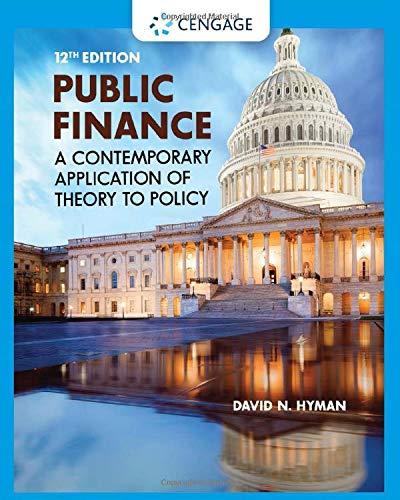Dhillon, Shilling, and Sirmans (Choosing between Fixed and Adjustable Rate Mortgages, Journal of Money, Credit, and Banking, 19(1), 1987, 260-267) estimate a probit model designed to explain the choice by homebuyers of fixed versus adjustable rate mortgages. They use 78 observations from a bank in Baton Rouge, Louisiana, taken over the period January 1983 to February 1984. These data are contained in the file sirmans.dat. The explanatory variables, and their anticipated signs, are FIXRATE (+)=fixed interest rate; MARGIN (-)=the variable rate the fixed rate; YIELD (-) = the ten-year Treasury rate less the one-year rate; MATURITY (-) = ratio of maturities on adjustable to fixed rates; POINTS(-) = ratio of points paid on an adjustable mortgage to those paid on a fixed rate mortgage; NETWORTH (+) = borrowers net worth. (i)Obtain the least square estimates of the linear probability model explaining the choice of an adjustable mortgage, using the explanatory variables listed above. Obtain the predicted values from this estimation. Are the signs consistent with expectation? Are the predicted values between zero and one?(ii)Estimate the model of mortgage choice using probit. Are the signs consistent with expectations? Are the estimated coefficients statistically significant?(iii)Using the probit estimates from part (b), estimate the probability of choosing an adjustable rate mortgage for each sample observation. What percentage of the outcomes do we successfully predict, using the rule that if , we predict that an 0.5adjustable rate mortgage will be chosen?




Statistic DF Value Prob 1 18.7979 <.0001 chi-square likelihood ratio continuity adj. mantel-haenszel phi coefficient contingency cramer v fisher exact test cell frequency left-sided pr right-sided>=F 0001 Table Probability (P) 50001 Two-sided Pre=P 50001 Odds Ratio and Relative Risks Statistic Value 95% Confidence Limits Odds Ratio 9.0682 3.1569 26.0485 Relative Risk (Column 1) 2.4032 1.4623 3.9493 Relative Risk (Column 2) 0.2650 0.1345 0.5220 probit The QLIM Procedure Predicted adjust by Regressor margin fixrate yield 1.0 0.8 0.6 0.4 0.2 0.0 12.0 12.5 13.0 13.5 14.0 14.5 0 2 4 6 1.4 1.6 1.8 2.0 Prediction maturity points networth 1.0 0.8 0.6 0.4. 0.2 0.0 0.5 1.0 1.5 2.0 2.5 0 1 2 3 4 0 5 10 15 probit The QLIM Procedure Discrete Response Profile of adjust Index Value Total Frequency 1 0 46 2 1 32 Model Fit Summary 1 adjust Number of Endogenous Variables Endogenous Variable Number of Observations Log Likelihood 78 39.20713 Maximum Absolute Gradient 1.02737E-6 Number of iterations 21 Optimization Method Quasi-Newton AIC 92.41426 Schwarz Criterion 108.91122 Goodness-of-Fit Measures Measure Value Formula Likelihood Ratio (R) 27.19 2* (LogL - LogLO) Upper Bound of R (U) 105.6 -2* LogLO Aldrich-Nelson 0.2585 R/ (R+N) Cragg-Uhler 1 Cragg-Uhler 2 0.2943 1 - exp(-R/N) 0.3968 (1-exp(-R/N))/(1-exp(-U/N)) 0.3317 1 -(1-R/UM (U/N) Estrella Adjusted Estrella 0.1653 1-((LogL-K/LOGLOY"(-2/N*LogLO) McFadden's LRI 0.2575 RIU Veall-Zimmermann 0.4494 (R* (U+N))/(U* (R+N)) McKelvey-Zavoina 0.4205 N = # of observations, K= # of regressors Algorithm converged. Parameter Estimates Standard Error t Value Approx Pr> [t| Parameter DF Estimate Intercept 1 -1.877265 4.120715 -0.46 0.6487 fixrate 1 0.498728 0.262498 1.90 0.0574 margin 1 -0.430951 0.173907 -2.48 0.0132 yield 1 -2.383963 1.083032 -2.20 0.0277 maturity 1 -0.059185 0.622583 -0.10 0.9243 points 1 -0.299914 0.241388 -1.24 0.2141 networth 1 0.083829 0.037853 2.21 0.0268 Probit model for adjust (row=True/column=predicted) The FREQ Procedure Table of adjust by phat Frequency Percent Row Pct Col Pct phat adjust 0 1 Total 0 46 58.97 38 8 48.72 10.26 82.61 17.39 77.55 27.59 1 32 41.03 11 21 14.10 26.92 34.38 65.63 22.45 72.41 Total 49 29 78 62.82 37.18 100.00 Statistics for Table of adjust by phat Statistic DF Value Prob Chi-Square 1 18.7979 =F 0001 Table Probability (P) 50001 Two-sided Pre=P 50001 Odds Ratio and Relative Risks Statistic Value 95% Confidence Limits Odds Ratio 9.0682 3.1569 26.0485 Relative Risk (Column 1) 2.4032 1.4623 3.9493 Relative Risk (Column 2) 0.2650 0.1345 0.5220 probit The QLIM Procedure Predicted adjust by Regressor margin fixrate yield 1.0 0.8 0.6 0.4 0.2 0.0 12.0 12.5 13.0 13.5 14.0 14.5 0 2 4 6 1.4 1.6 1.8 2.0 Prediction maturity points networth 1.0 0.8 0.6 0.4. 0.2 0.0 0.5 1.0 1.5 2.0 2.5 0 1 2 3 4 0 5 10 15 probit The QLIM Procedure Discrete Response Profile of adjust Index Value Total Frequency 1 0 46 2 1 32 Model Fit Summary 1 adjust Number of Endogenous Variables Endogenous Variable Number of Observations Log Likelihood 78 39.20713 Maximum Absolute Gradient 1.02737E-6 Number of iterations 21 Optimization Method Quasi-Newton AIC 92.41426 Schwarz Criterion 108.91122 Goodness-of-Fit Measures Measure Value Formula Likelihood Ratio (R) 27.19 2* (LogL - LogLO) Upper Bound of R (U) 105.6 -2* LogLO Aldrich-Nelson 0.2585 R/ (R+N) Cragg-Uhler 1 Cragg-Uhler 2 0.2943 1 - exp(-R/N) 0.3968 (1-exp(-R/N))/(1-exp(-U/N)) 0.3317 1 -(1-R/UM (U/N) Estrella Adjusted Estrella 0.1653 1-((LogL-K/LOGLOY"(-2/N*LogLO) McFadden's LRI 0.2575 RIU Veall-Zimmermann 0.4494 (R* (U+N))/(U* (R+N)) McKelvey-Zavoina 0.4205 N = # of observations, K= # of regressors Algorithm converged. Parameter Estimates Standard Error t Value Approx Pr> [t| Parameter DF Estimate Intercept 1 -1.877265 4.120715 -0.46 0.6487 fixrate 1 0.498728 0.262498 1.90 0.0574 margin 1 -0.430951 0.173907 -2.48 0.0132 yield 1 -2.383963 1.083032 -2.20 0.0277 maturity 1 -0.059185 0.622583 -0.10 0.9243 points 1 -0.299914 0.241388 -1.24 0.2141 networth 1 0.083829 0.037853 2.21 0.0268 Probit model for adjust (row=True/column=predicted) The FREQ Procedure Table of adjust by phat Frequency Percent Row Pct Col Pct phat adjust 0 1 Total 0 46 58.97 38 8 48.72 10.26 82.61 17.39 77.55 27.59 1 32 41.03 11 21 14.10 26.92 34.38 65.63 22.45 72.41 Total 49 29 78 62.82 37.18 100.00 Statistics for Table of adjust by phat Statistic DF Value Prob Chi-Square 1 18.7979











